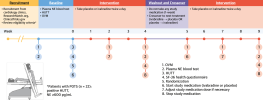I'm not entirely sure on that. You also have the additional problem of unblinding the PI, which I see no reason for introducing. Some of this will also depend on how much information was fed back to the participants.Agreed, although I don't think this breaks blinding any more than noticing an effect on heart rate and wellbeing might.
I agree they probably had justified resonse for a dose titration protocol. I don't think that is an issue. Additional problems occurring with blinding there could have probably been avoided to some degree by not feeding back any information to the patients as part of that and having the titration and measurements being taken by someone independent.
Regarding the number of dosage changes I'm thinking that this misses important details. From what I see only changes for the active drug are reported. That misses the point I made above. I'm not entirely sure about things either though.
Last edited:

